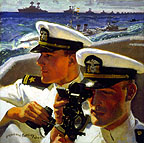Symon
Posts: 1928
Joined: 11/24/2012
From: De Eye-lands, Mon
Status: offline

|
I’m really enjoying this conversation. Where it has gone is certainly not OT from my original intent, but just to pull it back a bit to shipbuilding, and in line with what other people have posted, some of Japan’s wartime problems can be linked to their induction policy. There were no deferments for skill or education. A university graduate or a skilled ship fitter would find themselves equally liable to call-up and service as an infantry private, as a farmer’s son.
To save their irreplaceable skilled workers, the Mitsubishi’s, Kawasaki’s, and the like, had to negotiate with the Army for every individual body subject to induction. Even the Navy had to negotiate with the Army with respect to their civilian workers who were called-up. Some of this was alleviated by, in effect, “Navalizing” the shipyard workforces. But that caused problems of its own, as one might well expect.
Japan had a ‘significant enough’ proportion of population that was educated, and ultimately suitable/trainable for technical development, maintenance, and logistics. Unfortunately, liability for military service, and even rank within a service, was cultural and not experiential.
I often wonder what would have transpired if the optical physics students at Tokyo, Nagoya, Tohoku, and Osaka, would have been assigned to radar research programs, rather than being drafted as infantry privates. Likewise, 2/3 of Japan’s airframe, auto body, and engine mechanics were given a pair of boots and a rifle. What if they were assigned to aircraft support units, or the engineers, or even a transportation unit?
Wartime Japan was a poster study in manpower resource allocation and utilization dysfunction. I apologize to my Japanese friends for my bluntness, but you all know exactly what I’m talking about. Yamato’s armor was very strong and well positioned, but so badly welded that it cracked and broke.
The George and Frank were great planes; but the engine manufacturers didn’t have enough mechanics to get the motors tuned right. They never (rarely) ran to spec. The planes were down-rated in spec (Francillon’s data) and went into service where there were even fewer decent mechanics. Some squadrons had smart commanders who glommed onto every decent mechanic they could find, and the planes worked like they were supposed to. Just look at the wild data out there. A couple squadrons often kicked serious butt against first-line Allied aircraft; other squadrons, in the same plane, couldn’t dust a crop.
We tested those planes post-war, and they were as good as Japan’s hot squadrons showed. We used our own maintenance and standard 97 octane wartime gas (none of that super gas crap: another urban myth that really frosts my newts) and got (who’d a frikkin thunk?) exactly what the manufacturers had in mind and exactly what the poop-hot Japanese squadrons did.
Ouch, this is getting long. Wanted to talk about shipyards and ended up talking about airplanes, so let’s leave it here. Bottom line: they was good, they was innovative, they could have turned in a more credible later year performance. Um … um … err … Japan had her problems, and they were based on her cultural imperatives that were indeed left over from the Meiji Restoration. Butt  it could have been different. it could have been different.
Ciao. JWE
_____________________________
Nous n'avons pas peur! Vive la liberté! Moi aussi je suis Charlie!
Yippy Ki Yay.
|
 Printable Version
Printable Version














 it could have been different.
it could have been different. 




 New Messages
New Messages No New Messages
No New Messages Hot Topic w/ New Messages
Hot Topic w/ New Messages Hot Topic w/o New Messages
Hot Topic w/o New Messages Locked w/ New Messages
Locked w/ New Messages Locked w/o New Messages
Locked w/o New Messages Post New Thread
Post New Thread